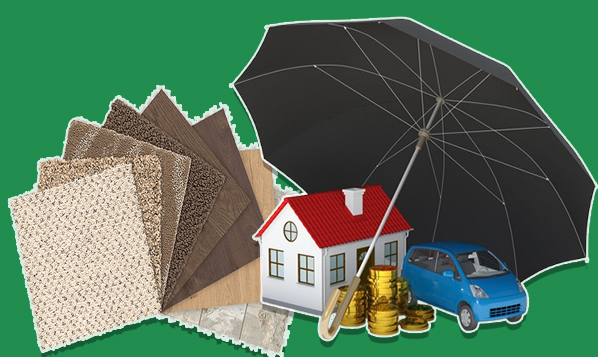Homeowners insurance aims to safeguard against various risks, but coverage for carpet and floor damage can be intricate. However, having a basic understanding if your homeowners’ insurance could cover carpet and floor damage is crucial. By being aware of these details, you can be rest assured that your homeowners can adequately cover and prevent unforeseen out-of-pocket costs.

Generally, standard homeowners insurance policies do not cover carpet or floor damage that results from normal wear and tear or neglect. However, if the damage is caused by a covered peril, like a fire, burst pipe, or natural disaster, your policy may help cover the cost of repair or replacement. It is important to review the details of your policy because coverage can vary depending on the insurer and the type of damage.
How Can Homeowners Insurance Cover Your Floor and Carpet Damage
Your condo or homeowners policy’s dwelling coverage can cover the cost of replacing or repairing your carpet and floors when a covered risk damages them. For example, your home insurance may cover the cost of new flooring if a fire damages your home’s floors, up to the limits of your policy and less your deductible.
However, renters insurance does not cover the actual building of the house, apartment, or condo you are renting. If a covered risk causes damage to the carpet or floors, your landlord’s insurance may pay for it.
Types of Carpet and Floor Damage Covered By Homeowners Insurance
Different kinds of floor damage are usually covered by homeowner’s insurance. However, the exact terms and conditions of your policy will determine the extent of coverage. The following are the most typical forms of floor damage that insurance usually covers:
Water damage
Floor damage caused by unexpected and unintentional water-related events, such as broken pipes, plumbing leaks, or appliance faults, is typically covered by insurance. Water damage can also degrade, deform, or stain carpet, laminate, hardwood, and other flooring materials.
Fire damage
Your homeowner’s insurance should cover any damage to your floors that results from a fire in your house. This includes heat, smoke, and flame damage, which can harm different types of flooring.
Storm damage
Damage to floors brought on by storms, hurricanes, tornadoes, and other extreme weather conditions is frequently covered by homeowner’s insurance. This can involve flooding, wind-driven rain, or water damage from roof leaks.
Falling objects
Your homeowner’s insurance should cover the cost of replacing or repairing your floors if a heavy object, like a tree limb during a storm or an incident involving construction, falls and damages them.
Vandalism and theft
Your insurance policy might pay for the required repairs or replacements if the thieves cause damage to your floors.
Impact damage
Your homeowner’s insurance usually covers damage to your floors caused by a covered risk, such as a car accident or falling debris.
Frozen pipes
If you have made reasonable efforts to prevent freezing, your insurance will cover the damage to your floors. Moreover, this can be caused by frozen pipes that burst in colder areas.
What Does Homeowners Insurance Not Cover for Carpet and Floor Damage
It’s crucial to remember that although unexpected and unintentional damage to floors is usually covered by homeowner’s insurance, there are several circumstances in which it might not. For instance:
Gradual wear and tear
Generally, insurance does not cover normal wear and tear over time. Your floors might not be covered if they deteriorate as a result of age or neglect.
Flood damage
Flood-related damage is not covered by standard homeowner’s insurance. To be covered for such occurrences, you would require a separate flood insurance policy.
Earthquake damage
Basic homeowner’s insurance does not cover earthquake damage. If you reside in an area that is prone to earthquakes, you might need to get special earthquake insurance coverage.
Termite or pest damage
Typically, typical homeowner’s insurance does not cover damage brought on by termites, insects, or vermin.
Thoroughly review your homeowner’s insurance policy to understand the specific risks and exclusions covered to ensure adequate coverage for your floors. To adequately protect your investment, ask your insurance provider about additional coverage options or endorsements if you have valuable or unusual flooring materials.
Is It Worth Claiming For Carpet Damage On My Home Insurance
Having your insurance company pay for carpet replacement could save you money because it can be expensive. However, it might not be cost-effective to file a claim if the damage is easily repaired or if the carpet only covers a limited area. The excess on insurance coverage can be nearly as expensive to file a claim as it would be to cover the damage yourself. Additionally, filing a claim could result in higher rates and the loss of any no-claims discount. Therefore, before determining if a claim is worthwhile, consider the costs.
Are Landlords Responsible For Carpets
The landlord is frequently in charge of maintaining the carpet in rental units. Before renters move in, landlords are required to make sure the property is livable and in good shape, including the carpets. This obligation extends beyond minor aesthetic concerns to wear and tear.
However, there may be a complicated interplay between a tenant’s insurance and a landlord’s policy. To comprehend their coverage, tenants should study their insurance plans. Therefore, landlords usually carry insurance for the structure and its fixtures, although this usually does not cover tenants’ deliberate damage.

